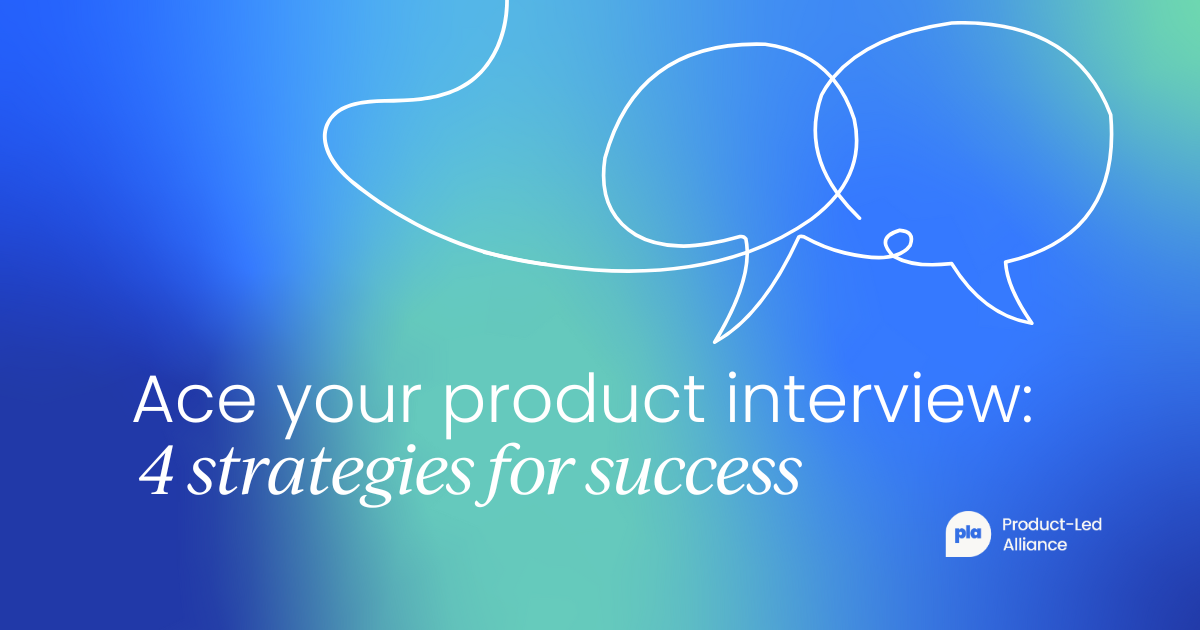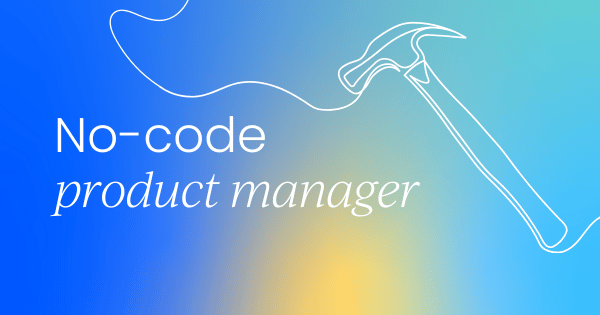What is a no-code product manager?
A no-code product manager is a specialist PM who focuses on developing digital products with the use of drag-and-drop no-code tools (rather than traditional coding methods).
It’s a growing role within the product management space due to the rising popularity of no-code tools, and the ability for a no-code PM to speed up production by creating products, websites, and automations without the need for a dedicated developer.
Builds created by PMs on no-code platforms can either be shipped as is after a quality check, or be used as a reference for developers, creating less back and forth to achieve the product or feature requirements.

Responsibilities of a no-code PM
A no-code PM’s role involves validating ideas and launching products at an accelerated pace. By bypassing traditional development cycles, they can create and test minimum viable products (MVPs) and prototypes quickly, allowing for rapid iteration based on user feedback.
Their work emphasizes the strategic aspects of product management – understanding user problems, defining requirements, and building a product that solves a genuine need.
Some other key responsibilities of a no-code PM include:
- Owning the product roadmap, defining what to build and why
- Conducting user research
- Analyzing data
- Ruthlessly prioritizing features based on user needs, business goals, and the capabilities of the no-code tools at their disposal
- Building internal tools to solve business problems
- Using automation tools to reduce manual work and improve efficiency for internal teams
Skills of a no-code PM
No-code product managers need to be competent in the skills of a traditional PM, such as:
- Problem-solving
- Data analysis
- Cross-functional collaboration & communication skills
- An understanding of the product development lifecycle
- Prioritization
On top of these, they need to be proficient in using a range of no-code platforms. This allows no-code PMs to effectively translate business goals into functional products and collaborate with both technical and non-technical teams.

How to use no-code tools in product management
No-code tools offer product managers a way to accelerate their work and focus on strategic outcomes rather than technical implementation.
Here are some of the key use cases for no-code tools in product management:
1. Rapid prototyping and MVP development
This is arguably the most impactful use case for no-code tools.
Instead of waiting for a development team to build a new feature or product, a PM can use no-code platforms to create a clickable, functional prototype or even an entire minimum viable product (MVP).
This allows them to:
- Validate ideas quickly: Get a working version of the product into the hands of users to gather real-time feedback and prove a concept before investing significant time and resources.
- Test user flows: Create interactive mockups and user journeys to test how users will navigate the product, identifying friction points and improving the user experience early in the process.
- De-risk product launches: A functional MVP provides a tangible product to show to stakeholders and early adopters, reducing the risk of building something nobody wants or needs.

2. Building internal tools and dashboards
Many product teams have internal needs that fall outside the scope of the main product. No-code tools are perfect for this. PMs can use them to build custom internal applications and dashboards that solve specific business problems, such as:
- Customer support portals: Create a simple tool for a customer support team to manage and track tickets or access customer data from multiple sources.
- Project management dashboards: Build a custom dashboard that aggregates data from different tools like Jira, Trello, and Google Sheets to give a real-time, consolidated view of project progress.
- Workflow automation: Automate repetitive tasks by connecting different apps and services. For example, a PM could set up an automation that automatically adds customer feedback from a survey to a product roadmap in Notion or Airtable.

3. Streamlining data and research workflows
Data is a PM's best friend, but accessing and organizing it can be a hassle. No-code tools simplify this process by providing a flexible layer on top of raw data.
A PM can:
- Consolidate customer feedback: Collect feedback from multiple channels (e.g., email, surveys, social media) and automatically organize it into a single database.
- Create user research panels: Build a simple web form to recruit users for testing and then use an automation tool to automatically schedule interviews and send calendar invites.
- Visualize data: Create custom dashboards that pull data from various sources (e.g., Amplitude, Google Analytics, spreadsheets) to visualize key metrics in a way that is easy for the entire team to understand.
By leveraging no-code tools for these use cases, a product manager can become more agile, efficient, and influential within their organization.
They can act as a mini “maker” and a strategic leader, bridging the gap between an idea and a tangible product without waiting for a full development cycle.

Best no-code tools for product management
Let’s explore some of the industry-standard no-code tools for product management and their use cases. It’s important to have some familiarity with a few platforms from each category to effectively take on the role of a no-code PM.
1. Web and app builders
These tools are used to create the user-facing front end of a product, such as websites, web apps, and even native mobile apps, without writing any code.
They are perfect for building prototypes, MVPs, and even full-scale products.
- Bubble: A powerful platform for building complex, logic-driven web applications without code.
- Webflow: Creates highly customizable, production-ready websites and content-driven web apps for designers.
- Adalo: A simple drag-and-drop tool for designing and building native-feeling mobile and web apps.
- Softr: Instantly turns your Airtable or Google Sheets data into a functional web application or portal.
2. Internal tools and databases
These tools are essential for organizing data, managing projects, and building internal applications to streamline processes and improve team efficiency.
- Airtable: A flexible hybrid of a spreadsheet and a database for organizing and connecting data.
- Coda: A customizable document that combines text, tables, and buttons to build powerful internal tools.
- Budibase: An open-source platform for building secure, custom internal dashboards and business apps.
3. Automation and data integration
Automation tools connect different applications, allowing you to automate workflows and move data without manual intervention. This is crucial for creating efficient systems and focusing on higher-value work.
- Zapier: Connects and automates workflows between thousands of different applications.
- Make: A powerful visual platform for building complex, multi-step automations and data workflows.
- Parabola: Automates complex data manipulation by connecting, transforming, and preparing data from various sources.
4. Prototyping and UI design
These are the industry-standard tools for creating detailed, interactive prototypes and high-fidelity mockups that look and feel like a finished product.
- Figma: The industry-standard, collaborative tool for designing and prototyping high-fidelity user interfaces.
- Adobe XD: A professional vector-based tool for designing and prototyping interactive websites and apps.
- InVision: Turns static designs into interactive, clickable prototypes with collaboration and feedback features.

How to become a no-code product manager
Build a portfolio
When building your portfolio don’t just list your projects – instead tell a story about them. Include details like, what the problem was, why you solved it that way, customer considerations or feedback you implemented, and the results from the project.
The first part of your portfolio should explore the problem you were trying to solve with the project. Discuss the user pain point or business challenge you’re trying to solve and use data, anecdotes, and user personas to make the problem tangible and relatable.
You may even want to highlight key aspects that are relevant to the role you’re applying for, so the interviewer can see how your project is relevant to the organization.
Next, it’s important to document your process of solving the problem, and building the project. Some key aspects to include are:
- User research: Summarize your research findings. Did you conduct user interviews, send out surveys, or analyze existing data? Showcase a few key quotes, an empathy map, or a summary of findings.
- Ideation and prioritization: Explain how you came up with different solutions. What frameworks did you use to prioritize features? Briefly mention the solutions you didn't choose and explain why.
- Prototyping: Share a link to a live prototype built with a no-code tool. This is where your practical no-code skills shine. A short demo video is also effective.
Then, share some insights into the final solution. Use visuals like screenshots, wireframes, or a video walkthrough to make it easy to understand.
Finally, don’t forget to share the impact of your work – if you can share the metrics you measured and what the result was (eg. 10% increase in conversions or 20% increase in signups).
Even if it's a personal project, you can hypothesize on what a successful outcome would look like (eg. "I would track user sign-ups and daily active users to measure engagement").
Tip: Try to highlight a few projects with a variety of problems and no-code tools used in the solution, to show the breadth and depth of your knowledge.

Tailor your resume
When tailoring your resume for a no-code product manager role, start by reframing your current experience to highlight the key skills and knowledge relevant to the role.
The goal is to show you have the right mindset and a proven ability to build and manage products. Even if you haven’t worked as a no-code PM, you can highlight key attributes like continuous learning, or an interest in building/development. You can also highlight any projects you’ve worked on involving a no-code platform.
Focus on highlighting your competence as a product manager, through skills like:
- Problem solving,
- Data analysis, and
- User empathy.
Then add in an additional section highlighting your no-code experience. Highlight the specific tools you have experience with as well as your ability to create mockups and prototypes.
Lastly, make sure you link to your portfolio, so hiring managers can easily access examples of your work.

Practice for interviews
Like any product management role, it’s important to show up prepared for the interview. This may include completing mock interviews, researching the company, or rehearsing some answers to common interview questions.
The questions you’ll face will likely be a mixture of standard product management questions, alongside some more specific no-code questions.
Some examples include:
- Behavioral questions, such as: “Tell me about a time you had to launch a product with limited resources. How did you prioritize?” or “Describe a time you had to get buy-in from a non-technical stakeholder for a new feature.”
- Product strategy questions, like: “If you were the no-code PM for our company, how would you improve [our product]?” or “How would you decide whether to use a no-code tool versus hiring a developer to build a new feature?”
- Execution questions such as, “A key metric for a product you built with no-code is dropping. How would you diagnose the problem?” or “Walk me through your process for building a prototype from an idea.”
- No-code specific questions, like “What are the limitations of a no-code platform you've used?” or “How do you ensure data security when using a no-code tool?”




 Follow us on LinkedIn
Follow us on LinkedIn











